Abstract
This comprehensive study provides an in-depth examination of the convective drying process and drying kinetics of ginger rhizomes (Zingiber officinale), precisely honing in on the influence of moisture content variation on the thermal property of thermal conductivity. Our research reveals a direct correlation between decreasing moisture content and thermal conductivity during drying, conducted under meticulously controlled conditions with a drying temperature range of 10 °C to 60 °C and an optimum drying temperature identified at 60 °C with a relative humidity of 35%. We scrutinise the thermal properties, namely, the thermal conductivity, in relation to moisture content, shedding light on the intricate dynamics involved. The study uncovers the distinct advantage of convective drying over traditional methods, shortening the drying time to just 24 h, compared to the nine and eight days required for open sun and solar tunnel drying, respectively. We identified optimal moisture levels for various ginger types: unblanched (6.63%, thermal conductivity 0.0553 , blanched (9.04%, thermal conductivity 0.0516 ), peeled (8.56%, thermal conductivity 0.0483 ), and unpeeled ginger (5.98%, thermal conductivity 0.0460 ). As drying progressed, the moisture content fell from 81% to approximately 6–9%, concomitantly lowering the thermal conductivity from roughly 0.0553 to around 0.0460–0.0516 . These findings offer significant implications for the food industry, proposing improvements in drying processes and strategies for energy conservation when drying ginger rhizomes and similar agricultural produce. Moreover, this study sets a solid foundation for future investigations into potential applications of these insights to other agricultural products and various drying techniques.
1. Introduction
Ginger (Zingiber officinale) is a widely used spice and medicinal plant known for its unique flavour and numerous health benefits [1]. Due to its high moisture content, fresh ginger is perishable, necessitating the development of preservation techniques to extend its shelf life and facilitate long-distance transportation [2]. Convective drying is a popular method of preserving ginger that involves the movement of hot air over the product to facilitate moisture evaporation [3]. This literature review examines the existing studies on the experimental investigation of convective drying of ginger rhizomes, focusing on the drying kinetics, quality attributes, and optimisation of drying conditions.
Numerous studies have focused on analysing the drying kinetics and developing mathematical models for the convective drying of ginger rhizomes. Li et al. [4] compared ginger’s hot and solar drying methods, determining that hot air drying resulted in faster drying rates and lower moisture ratios. Various mathematical models, including the Page, Henderson, Pabis, and Logarithmic models, have characterised the drying kinetics. The Page model was found to be the most suitable in the majority of cases [4,5].
In another study by Dincer and Dost [6], the drying kinetics of ginger were investigated using a laboratory-scale convective dryer. The researchers observed a decrease in the drying rate as the moisture content increased. The effective moisture diffusivity was calculated utilising Fick’s second law, indicating a significant correlation between temperature and air velocity.
Similarly, Nguyen et al. [7] discovered that elevating the drying temperature and air velocity resulted in higher effective moisture diffusivity in ginger rhizomes.
The impact of convective drying parameters on the quality attributes of dried ginger has been the subject of numerous investigations. Colour is an important parameter affecting the final product’s visual appeal and consumer acceptability [8]. Doymaz [9] reported that higher drying temperatures led to increased browning of ginger slices, suggesting a potential compromise in product quality. Similarly, Oyedele et al. [5] found that solar drying resulted in a darker colour than hot air drying, with the latter preserving the colour attributes better.
Volatile oil content and antioxidant capacity are other critical quality attributes of dried ginger, as they are directly linked to its flavour and therapeutic value [10]. Feng et al. [8] observed that ginger slices’ phenolic, flavonoid, and antioxidant activity increased with decreasing drying temperatures. In contrast, higher temperatures resulted in a significant loss of volatile oil content. This suggests that lower drying temperatures may be preferable for preserving the bioactive compounds in ginger.
Optimising the convective drying conditions for ginger rhizomes is crucial to balancing energy efficiency and product quality. Response surface methodology (RSM) has been widely employed for this purpose [4,7]. RSM is a statistical technique used to optimise multiple factors simultaneously, making it an effective tool for determining the optimal combination of drying parameters [11]. Afolabi et al. [4] used RSM to optimise the convective air-drying temperature for tiger nut, which has similar drying characteristics to ginger. They determined the optimal drying temperature to be 60 °C, which minimised energy consumption while maintaining product quality. Nguyen et al. [7] employed RSM to optimise the drying temperature, air velocity, and sample size for ginger rhizomes, finding that a temperature of 55 °C, an air velocity of 1.5 m/s, and a sample size of 5 mm provided the best combination of energy efficiency and product quality.
Recently, novel drying techniques and hybrid drying systems have been explored to improve the efficiency and quality of the convective drying of ginger rhizomes. These methods include microwave-assisted convective drying [2], infrared-assisted convective drying [12], and vacuum-assisted convective drying [13].
Alibas [2] compared microwave, air, and combined microwave-convective drying of pumpkin slices, a product with comparable properties to ginger. The study demonstrated that combined microwave-convective drying resulted in shorter drying times and better retention of colour and nutrient content than conventional convective drying. Erenturk et al. [12] investigated the infrared-assisted convective drying of carrot slices. They found that combining infrared and convective drying significantly reduced drying time without compromising product quality. Namsanguan et al. [13] studied the vacuum-assisted convective drying of ginger. They observed that the process resulted in higher retention of volatile oil content and better preservation of colour compared to traditional convective drying. Ikechukwu [14] studied the prediction of thin-layer drying characteristics of ginger rhizome slices in a convective environment. This investigation confirmed the superior efficacy of convective drying at higher temperatures, as it recorded the lowest moisture content. The study’s results established a clear connection between drying time, temperature, and the moisture content in ginger.
The primary focus of our current study is to delve into the intricacies of the convective drying process of ginger rhizomes. We’re particularly interested in exploring the correlation between moisture content and thermal properties. Existing research demonstrates that similar drying techniques can have a profound effect on the bioactive components in a variety of fruits. A study conducted by Bialik et al. [15] provides an exemplary model, exploring how vacuum and convective drying parameters can influence the total phenolic and carotenoid content, antioxidant capacity, and drying kinetics of kiwiberry (Actinidia arguta). Interestingly, they found that vacuum drying methods tend to preserve the phenolic content of kiwiberry more effectively. It was also noted that samples dried at 50 °C were nearly indistinguishable from their fresh counterparts. Regardless of the drying method, they observed that the fastest drying time was at a temperature of 70 °C.
Broadening our perspective, it is critical to recognise the advancements in drying techniques, especially those aimed at materials with high moisture content. Khalid Hamid et al. [16] highlighted this through their innovative research, examining the performance of a closed-loop heat pump dryer using a moisture-rich material known as Orbeez. Through their experiments, they examined different weights of Orbeez at a constant airflow rate to determine various performance metrics, such as the coefficient of performance of the heat pump, drying rate, condenser’s heat transfer rate, moisture extraction rate, and specific moisture extraction rate. Fascinatingly, the research indicated that increased test loads corresponded to improved performance and moisture extraction rates. It was also found that the water removal rate, dependent on moisture diffusivity, increased with higher drying air temperature and air velocity. Further, they incorporated a deep learning model to predict the outlet conditions of the dryer and weight reduction based on the input conditions of the dryer, time, and weight. This model proved exceptionally accurate, making it a potentially cost-effective solution for predicting the drying performance of different materials in a closed-loop heat pump dryer.
While our study is centred on the convective drying of ginger rhizomes, it is important to note that other scholars have applied various drying methods to different food substances. For example, Çelik and Kenanoğlu [17] researched aubergine seeds, Zhang et al. [18] on tiger nuts, and Akther et al. [19] on mango powder. These investigations were valuable in their contexts, providing significant insights into the drying processes of these individual food items. However, it is noteworthy that none of these studies explored the specific convective drying method we have employed in our research. As such, our investigation fills a knowledge gap in the study of convective drying processes, specifically focusing on the effects of moisture content on the thermal properties of ginger rhizomes.
Drawing inspiration from substantial contributions to the field, our research aims to provide comprehensive insights into ginger rhizomes’ drying behaviour and kinetics. This exploration could pave the way for developing more efficient drying procedures and preserving vital constituents. Specifically, our primary objective is to examine the convective drying process of Zingiber officinale (ginger) rhizomes sourced from the prominent ginger-producing states in Nigeria, including Kaduna, Bauchi, Benue, Gombe, and Nasarawa.
The study focuses on characterising the moisture content and thermal properties of these rhizomes during drying to understand how these parameters influence the efficiency of the convective drying process. By zeroing in on ginger rhizomes from these regions, we aspire to gather data representative of Nigeria’s major ginger-producing areas, subsequently offering invaluable insights that could be applied to optimise drying processes on a grander scale.
We acknowledge that these states’ specific climatic and soil conditions may impact the rhizomes’ properties, affecting the quality of the drying process and the final product. Understanding these dynamics can furnish crucial insights to facilitate quality control of dried ginger rhizomes and potentially enhance the beneficial properties of the end product. This understanding could also foster the development of more energy-efficient and cost-effective drying techniques for ginger and other agricultural products, significantly impacting the food processing industry.
While our study is comprehensive, it is not devoid of limitations. Primarily, it only includes ginger varieties from northern Nigeria, possibly limiting the findings’ generalisability to other ginger types in different regions or countries. The study’s focus on moisture content and thermal conductivity overlooks other potentially significant parameters, such as shrinkage, colour change, and textural alterations, which could critically affect the dried product’s quality. Lastly, our research exclusively employs convective drying, neglecting other drying methods that could yield differing results. We anticipate that future research addressing these limitations could provide more comprehensive insights, further enriching our understanding of the drying processes of ginger rhizomes.
Our study’s findings are expected to interest professionals and researchers in food science and technology, agricultural engineering, and crop processing. Moreover, the insights from this research could provide a foundation for future studies on the drying processes of other significant agricultural crops within Nigeria and similar climatic regions.
2. Materials and Methods
2.1. Raw Material: Ginger Rhizomes
The experiment employed ginger rhizomes that originated from Nigeria and were kept at room temperature before use. The required quantity of samples (as shown in Figure 1) was measured using a cutting device to ensure accuracy. The University of Greenwich’s Hawke Building provided a temperature and humidity-controlled chamber for drying the ginger at different temperatures (ranging from 10 °C to 60 °C) for varying periods (2, 4, 8, 10, 14, 18, and 24 h). The thermal conductivity of the specimens was measured using the Linear Heat Conduction Experimental Unit. The author used special scoopers to slice the gingers into pieces measuring 30 mm in diameter and 18 mm in thickness. Moisture content was calculated using Equation (2). Figure 2 show the flow chart of the drying processes and thermal conductivity.
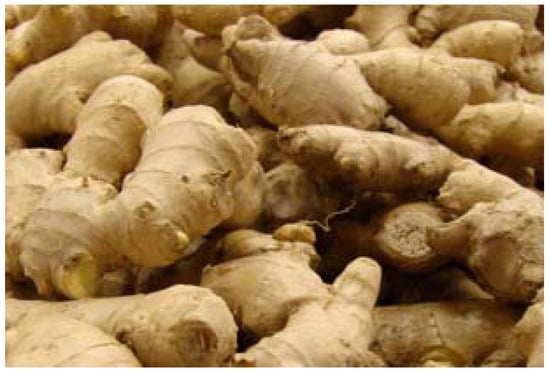
Figure 1.
Raw materials for the experiments (ginger rhizomes).
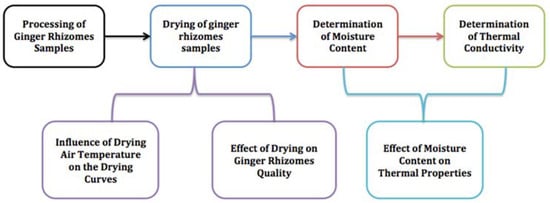
Figure 2.
Flow chart of the drying processes and thermal conductivity.
2.2. Processing of Raw Material
The ginger rhizomes that were used for the experiment will be classified under [20,21,22,23]:
- Blanched Ginger Rhizomes: Blanched ginger rhizomes have been briefly exposed to boiling water or steam to inactivate enzymes, reduce the microbial load, and partially soften the tissue. This pre-processing step can help retain colour, improve texture, and prolong the shelf life of the dried product. However, blanching may cause some loss of volatile compounds responsible for ginger’s characteristic aroma and flavour.
- Unblanched Ginger Rhizomes: Unblanched ginger rhizomes are raw and have not been subjected to heat treatment before drying. They retain their original colour, aroma, and flavour but may take longer to dry than blanched samples due to the active enzymes and higher initial microbial load. Unblanched samples may also have a shorter shelf life than their blanched counterparts.
- Peeled Ginger Rhizomes: Peeled ginger rhizomes have had their outer skin removed, exposing the inner flesh. This pre-processing step can result in a more uniform drying process and improved product quality, as removing the skin can facilitate moisture loss and enhance heat transfer. Peeled ginger may also be more visually appealing and easier to process or grind after drying.
- Unpeeled Ginger Rhizomes: Unpeeled ginger rhizomes still have their outer skin intact, which may slow down the drying process due to the additional layer that moisture must penetrate to escape. This can lead to longer drying times and uneven drying. However, the skin can protect against the loss of volatile compounds and may help retain some of the ginger’s aroma and flavour during drying.
2.3. Experimental Instruction
2.3.1. Blanched
- Take a big pot and fill it halfway with water. Place it on the stove and turn the heat up to high. Add some salt to the water.
- Peel the outer layer of ginger by slicing it vertically and horizontally.
- Put the ginger in the pot of boiling water. Set a timer for 2 min.
- After blanching, remove the ginger from the pot and transfer it into ice-cold water to stop cooking immediately.
- Wait for 2 min before taking out the blanched ginger. Then, put them on a plate lined with paper towels to dry.
2.3.2. Unblanched
- Ginger that has not been washed and is still fresh.
2.3.3. Peeled
- First, rinse the ginger and remove any dirt.
- Then, take a piece of ginger and use a spoon to scrape off the skin from the edges.
2.3.4. Unpeeled
- Washed ginger and then kept it unpeeled.
2.4. Equipment
2.4.1. ARS-0680 Environmental Stress Chamber
The ARS-0680 Environmental Stress Chamber is versatile drying equipment designed to simulate various environmental conditions to study the drying behaviour of various materials, including ginger rhizomes. This chamber enables researchers to conduct controlled experiments by accurately adjusting and maintaining temperature, humidity, and air velocity parameters.
Equipped with advanced sensors and a user-friendly control system, the ARS-0680 allows for precise monitoring and regulation of the chamber’s internal environment. This ensures that the drying conditions remain consistent throughout the experiment, providing reliable and reproducible results.
The chamber’s adaptability makes it suitable for investigating the drying kinetics of ginger rhizomes under various convective drying conditions and assessing the influence of moisture content on the thermal properties of the dried samples. Consequently, the ARS-0680 Environmental Stress Chamber is a valuable tool for researchers aiming to optimise the drying process and improve the quality of dried ginger rhizomes.
2.4.2. TD1002A—Linear Heat Conduction Experiment
The TD1002A [2]—Linear Heat Conduction Experiment is a laboratory-based educational apparatus designed to study and demonstrate the principles of linear heat conduction in various materials. This apparatus allows a thorough understanding of the heat conduction process and how it is influenced by factors such as material type, cross-sectional area, and temperature gradient.
The TD1002A consists of a primary unit, which includes a heat source, sample holder, temperature sensors, and a cooling system. The apparatus allows for testing various sample materials, such as ginger rhizomes used for this research. These samples, typically rods or bars, are mounted on the sample holder and exposed to a controlled temperature gradient.
The heat source generates a constant heat flux during the experiment, which is transferred through the sample material. The temperature sensors, positioned along the length of the sample, measure the temperature at various points, allowing for the determination of the temperature gradient across the material. The cooling system maintains a constant temperature at the other end of the sample, ensuring a steady-state heat conduction process.
Examining temperature sensor data makes it possible to determine the thermal conductivity of the sample material by applying Fourier’s Law of Heat Conduction. This permits a comparison of the ginger rhizomes’ thermal conductivity and an appreciation for how material properties and temperature differences affect heat conduction mechanisms.
The TD1002A—Linear Heat Conduction Experiment facilitates the study of linear heat conduction principles in ginger rhizomes. The apparatus allows for hands-on experimentation and data analysis, providing a comprehensive understanding of heat conduction processes and the material properties of the specimen used in this work.
A consistent power output of 20 watts was utilised during the experiment to supply the cylinder. The fresh ginger rhizomes provided for the study had dimensions of 30 mm in diameter and 18 mm in thickness. Figure 3 displays the arrangement of this equipment [1].
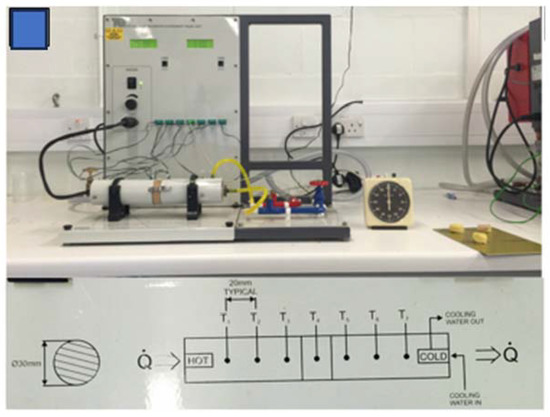
Figure 3.
TD1002A refers to the Linear Heat Conduction Experiment Unit (LHTEU), which is paired with the TD1002 Heat Transfer Experiments Base Unit [24].
To ensure the accuracy and reproducibility of the experiments, a cylindrical scooping device was specifically designed to create ginger rhizomes with precise dimensions. The ginger rhizomes used in the experiments had a diameter of 30 mm and a thickness of 18 mm. These specific dimensions of the ginger samples are crucial for maintaining the validity of the results. The size and shape of the ginger samples can significantly impact various aspects of the drying process and influence the measured thermal properties.
Here are some reasons why the cylindrical rod chopping device, designed to produce ginger samples of a specific size and shape, is important in this work:
- Consistency and Reproducibility: Having a standard size and shape for all samples ensures that every experiment’s conditions are identical. This consistency is critical for obtaining reliable and repeatable results. It ensures that any differences observed are due to the experimental variables being tested, not differences in the sample sizes.
- Heat and Mass Transfer: A sample’s size and shape can affect the heat and mass transfer rates during drying. Smaller or thinner samples may dry faster due to a larger surface area exposed to the drying conditions, while larger or thicker samples may take longer to dry.
- Quality of Dried Product: The size and shape of the sample can also influence the quality attributes of the dried product, such as its texture, colour, and flavour. Consistent size and shape help ensure uniform quality in the dried product.
- Data Interpretation: When analysing and interpreting the data obtained in this work, knowing that all samples were of the same size and shape eliminates one potential source of variability. This makes it easier to draw accurate conclusions from the data.
3. Methodology
3.1. ARS—0680 Temperature and Humidity Chamber: Drying Experiment
Shortly after the ginger samples have been prepared under the classifications below:
- Blanched;
- Unblanched (pre-treatments);
- Peeled;
- Unpeeled.
The experiment involved subjecting 16 samples to an accelerated thermal condition at temperatures ranging from 10 °C to 60 °C for various durations (2, 4, 8, 10, 14, 16, and 24 h) with a dwell time of 10 min starting at a room temperature of 24 °C in an environmental chamber. Initially, the samples were programmed to run for 2, 4, 8, and 10 h each before being removed for analysis of their initial moisture content. The TD1002A—Linear Heat Conduction Experimental Unit was also used to determine thermal conductivity.
3.2. Linear Heat Conduction Experiment
To conduct the linear Heat Conduction Experiment for ginger rhizomes, the following methodology was employed:
- Sample Preparation: Slice ginger rhizomes into uniform samples with a consistent thickness and cross-sectional area, ensuring the samples are large enough to fit into the TD1002A Linear Heat Conduction apparatus. Record the initial moisture content of the samples.
- Apparatus Set-up: Mount the ginger rhizome samples onto the TD1002A Linear Heat Conduction apparatus sample holder, ensuring proper contact with the heat source and the cooling system. Attach temperature sensors at regular intervals along the length of the samples to monitor the temperature gradient during the experiment.
- Drying Process: Using the ARS-0680 Environmental Stress Chamber, subject the ginger rhizome samples to convective drying under controlled conditions. Set the desired temperature, humidity, and air velocity within the chamber to simulate different drying scenarios. Continuously monitor and record the temperature readings from the sensors and the weight loss of the samples to determine the moisture content at different stages of the drying process.
- Data Collection and Analysis: Gather temperature and moisture content data at different stages during the experiment. Use this data to determine the temperature gradient across the samples and compute the associated thermal conductivity with the help of Fourier’s Law of Heat Conduction. Create a graph to visualise the drying kinetics and explore the correlation between moisture content and thermal conductivity.
- Comparative Analysis: Compare the thermal conductivity values of ginger rhizomes under various moisture content levels and drying conditions and evaluate how the moisture content impacts the thermal properties of dried ginger rhizomes.
- Conclusions and Recommendations: Drawing upon the experiment’s outcomes, decide on the efficiency of convective drying when applied to ginger rhizomes and how moisture content impacts their thermal characteristics. Additionally, it suggests enhancing the drying procedure and elevating the standard of dried ginger rhizomes.
3.3. Experimental Procedure
The ginger root was sliced into pieces measuring 30 mm × 18 mm and subjected to drying under various conditions (unblanched, blanched, peeled, unpeeled) at temperatures ranging from 10 °C to 60 °C using ARS-0680 Environmental chambers for different durations. Before the experiment, the equipment was allowed to run for at least half an hour to maintain the desired humidity, velocity, and air temperature. Dehydration began at 8:00 am and continued until the desired moisture content was achieved for each experimental condition. The weight of the samples was recorded every two hours during the drying process using an electronic balance (EK-200 g, Max 200 ± 0.01 g). After completion of the drying process, the dried samples were collected, and their thermal conductivity was measured using linear heat conduction equipment. The samples were then cooled and stored in a sealed container for comparison with other samples with regard to changes in size, shape, and colour.
The drying process of ginger rhizomes can be divided into three distinct phases.
- The first phase, known as the preheating phase, involves heating the ginger rhizomes to match the temperature of the surrounding air. During this stage, moisture removal from the samples is slow because most of the heat energy is used to raise the temperature of the ginger.
- The second phase, the constant rate drying phase, occurs when external factors such as humidity, temperature, and air velocity govern the constant pace at which moisture is removed from the ginger rhizomes. This period is characterised by a straight line on the drying curve since there is continuous evaporation of surface moisture while moisture inside migrates towards it.
- Lastly, during the falling rate drying phase, internal factors such as resistance to moisture migration and reduced moisture content gradually decrease the moisture removal rate until an equilibrium point is reached. This stage can be further subdivided into two sub-phases:
- First Falling Rate Period and Second Falling Rate Period. In these periods, there is a gradual decrease in drying rate due to limited moisture migration from deep within the sample and the tightening grip of the remaining retained water bound to solid components of ginger rhizomes. leading to a slower reduction in water content levels.
3.4. Determination of Moisture Content and Thermal Conductivity
3.4.1. Assessment of Moisture Levels
Ginger has a notably high initial moisture content compared to other farm products. Determining this initial moisture content is crucial, as it directly influences various aspects of the drying process [4]. Furthermore, knowing the initial moisture content is critical to understanding the drying procedure. The range is approximately from 87.98% and 84.97% moisture content (on a wet basis) down to 75.73% and 68.70% (on a wet basis) in a blanched state and to moisture contents of 81.98% (wb) and 77.46% (wb) in a non-blanched condition after spending 20 h in a solar dryer at temperatures between 50 °C and 60 °C [5]. Ginger rhizomes, when split, dehydrate from an initial moisture content of 87.98% (wb) to 22.54% and 32.96% (wb) under blanched and unblanched conditions, respectively, over 32 h at 50 °C. This information is especially relevant to importers and exporters dealing with countries with lower ginger requirements or farmers wishing the rhizomes to sprout. It also indicates that the drying rate of ginger rhizomes increases as the drying temperature rises. Thus, the determination of initial moisture content and the assessment of moisture content at various stages were crucial aspects of this research [4,6,7].
3.4.2. Method for Assessing Moisture Levels
- The initial weight of the ginger sample was documented using “Analytical Plus Electronic Balances”, precise to 0.00001 g.
- The ginger was then transferred into a controlled environment at a steady temperature ranging from 10 °C to 60 °C for 2, 4, 8, 10, 14, 18, and 24 h.
- The weight of the dried ginger samples was then measured at the time intervals mentioned above.
- The weighing of the ginger samples continued until a steady, final weight was achieved, indicating an equilibrium state had been reached.
The ginger’s initial moisture content (wb) was then calculated using Equation (1). This experiment consistently utilised the moisture content on a wet basis.
The moisture content on a wet basis is the quantity of water per unit mass of a moist or humid (or wet) model.
In the study of the drying process of Zingiber officinale (ginger) rhizomes, a critical factor that we focus on is the moisture content. The moisture content of a material is a vital parameter in the study of drying kinetics, significantly impacting the final product’s quality, safety, and shelf life. It is typically represented in two ways: on a wet basis and on a dry basis .
Moisture content on a wet basis is defined as the mass of water present in a material expressed as a percentage of the total mass of the material (i.e., the sum of the dry matter and the water content). This is a commonly used measure in the food industry. It directly represents how much water is present compared to the total weight, making it easy to understand and use in practical applications. On the other hand, moisture content on a dry basis is defined as the mass of water present in a material expressed as a percentage of the dry matter mass. This is especially useful in scientific studies and calculations where we want to understand the water content independent of any changes to the dry matter.
In our study, we measure and track both and of the ginger rhizomes throughout the drying process. These measures provide insights into how the drying process progresses and how effectively the water is removed. Furthermore, understanding the changes in and over time can help us optimise the convective drying process, contributing to an improved quality of the dried ginger rhizomes and potentially enhancing the beneficial properties of the end product.
In addition to monitoring the moisture content, we also study the drying rate and the overall drying rate of the ginger rhizomes during the convective drying process. The drying rate, generally expressed in terms of moisture removed per unit time, is a significant parameter that provides insights into the efficiency of the drying process. It can be influenced by various factors such as temperature, humidity, air velocity, and the size and shape of the dried material.
The overall drying rate considers the total drying time, representing the average moisture removal rate over the entire drying period. This is an important parameter as it gives us a comprehensive understanding of the drying process’s effectiveness.
By examining both the instantaneous and overall drying rates, we can identify the stages of the drying process and understand the changes in drying dynamics over time. This knowledge is crucial for optimising drying procedures, reducing energy consumption, and maintaining high-quality output in the drying of Zingiber officinale rhizomes. These parameters, combined with the moisture content, both on a wet and dry basis, will provide a comprehensive picture of the drying characteristics of the ginger rhizomes, leading to an enhanced understanding of the convective drying process.
Mathematical representation of moisture content (%) calculation:
Moisture content on a dry basis is the amount of water per unit mass of dry solids (bone dry) in the sample.
Thus,
Note that the following equation relates the two moisture contents:
Drying Rate
The calculation of drying rates at various times throughout the drying process in the environmental chamber was performed under all experimental conditions using the subsequent formula [8].
where is the drying rate (kg water/kg of materials. min), t is the time (min), and are the initial and final moisture content, respectively [8].
Overall Drying Rate
The influence of air velocity and temperature on the total drying rate is determined using the method of variance analysis. The total drying rate is a difference ratio between the initial and final moisture content and the total drying period. The calculation for the overall drying rate is as follows:
The moisture content on a dry basis can exceed 100% due to the possibility of the water volume in a sample being greater than the number of dry solids present. The dry basis is commonly used to estimate the percentage of moisture content of a material without moisture, assuming it does not lose mass during the drying process. This concept of bone-dry matter ensures mass balance throughout the drying process. However, there are cases where the moisture content on a wet basis may be more suitable for specific applications [4]. In Figure 4, there are photographs depicting samples and the equipment used to measure the weight of the samples before and after dehydration.
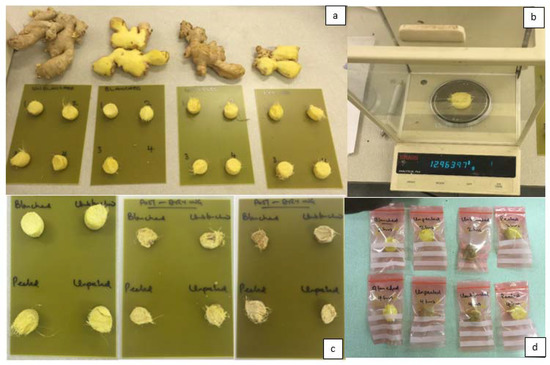
Figure 4.
(a) Freshly prepared samples; (b) analytical plus electronic balances by Ohaus for measurement of samples; (c) samples after 2–24 h and 10–60 °C; (d) bagged sample after drying.
3.4.3. Determination of Thermal Conductivity
The thermal conductivity of a material is defined as the amount of energy transferred within a unit area and thickness of the material in a given time. At the same time, the temperature difference between the surfaces initiating the heat flow is one unit of temperature. Figure 5 illustrates that materials with high thermal conductivities are superb conductors of heat. Heat conduction happens most readily in pure metals, less so in alloys, and even less in non-metals. Certain thermal insulators’ extremely low thermal conductivities, like cork, can be attributed to their porosity and absorbency. Furthermore, thermal conductivity is remarkably low in agricultural farm products. Figure 6 shows the powdered ginger rhizomes with a thermal conductivity of 0.0503 W⁄(m∙K).

Figure 5.
Thermal conductivity—low values characterise insulation materials, and metals with high values [23].
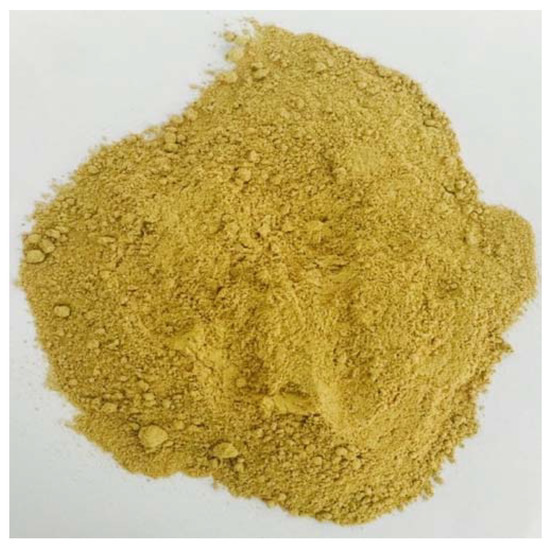
Figure 6.
Powdered ginger rhizomes with a thermal conductivity of 0.0503 .
The following features determine thermal conductivity:
- Structure of materials;
- Wetness of the content (moisture content);
- Materials density;
- Temperature and pressure (operational settings) [10].
Mathematical Representation of Thermal Conductivity of Ginger Rhizomes
4. Results and Discussions
The drying characteristics of ginger rhizomes were examined using experimental drying curves at various conditions. Drying curves were studied over 2–24 h, with average moisture content ranging from 78.74% (on a wet basis) at 10 °C to a final moisture content of 5.98% (on a wet basis) at 60 °C. These samples were then utilised to calculate the individual thermal conductivity of the ginger product. Additionally, the research explored the influence of moisture content on thermal conductivity over time.
Two primary aspects of convective drying of ginger rhizomes were investigated in this study: firstly, to identify the moisture content characteristics, and secondly, to determine the thermal conductivity of each sample at different drying times and temperatures using the Linear Heat Conduction Experimental unit.
Drying is an essential process for preserving and storing ginger rhizomes and directly impacts the quality of the end product. The drying air temperature plays a significant role in shaping the drying curves and determining the quality of dried ginger rhizomes. Gaining insights into how the temperature of the drying air influences drying kinetics and quality characteristics is key to optimising the drying procedure.
- Impact of Drying Air Temperature on Drying Patterns: Increased drying air temperatures lead to a more rapid drying rate, mainly due to the enhanced heat and mass transfer between the ginger rhizome and the surrounding air. At higher temperatures, drying curves usually display a swift initial drying rate, which then transitions to a slower, more steady decline in moisture content. This results in shorter drying durations, a plus for large-scale processing and energy efficiency.
However, overly high drying temperatures can induce case hardening, where the outer surface of the ginger rhizome dries faster than the interior, forming a hardened shell that hampers additional moisture extraction. This may prolong the drying duration and lead to uneven drying, adversely affecting the final product’s quality.
- 2.
- Impact of Drying on the Quality of Ginger Rhizomes: The temperature of the drying air significantly influences the quality of the dried ginger rhizomes. Drying can alter critical quality characteristics like colour, aroma, flavour, and texture.
- Colour: Elevated drying temperatures can cause browning or discolouration of ginger rhizomes due to non-enzymatic browning reactions or pigment oxidation.
- Aroma and Flavour: The drying procedure may result in the loss of volatile compounds responsible for ginger’s unique aroma and flavour. Higher temperatures can intensify these losses, making a final product less aromatic and flavourful.
- Texture: High drying temperatures can induce case hardening, affecting the texture of dried ginger rhizomes and making them harder to grind or process.
Striking a balance between the drying air temperature and the drying duration is crucial to optimise the drying process while preserving the quality of dried ginger rhizomes. By judiciously selecting the appropriate drying temperature, it is possible to minimise quality degradation while maximising drying efficiency and energy conservation. Further studies could examine different drying methods, such as vacuum or freeze-drying, to better preserve the quality attributes of dried ginger rhizomes.
In this research, while numerous aspects of the convective drying process of Zingiber officinale (ginger) rhizomes were studied in detail, certain factors, such as the colour parameters of the dried rhizomes, were not included. The study of colour parameters can provide additional insights into the quality and acceptability of the dried ginger rhizomes, as colour changes can often signify crucial changes in the product during the drying process.
However, our current research objective focuses primarily on understanding the drying kinetics, explicitly looking at the moisture content (both on a wet and dry basis), drying rate, and overall drying rate, and their relationship with the efficiency of the drying process. Colour parameters, while valuable, fall outside the scope of our present study.
Our decision to exclude colour parameters from this research was based on the aim of delving deeply into the dynamics of moisture content and drying rates. We believe these factors are of primary importance in optimising the convective drying process and improving the quality of the dried ginger rhizomes. While colour parameters are not considered in this work, we acknowledge their importance and suggest they be considered for future research, as they could potentially provide further insights into the visual quality and consumer acceptance of the dried ginger product.
4.1. Measurement of Moisture Content and Thermal Conductivity
Our research studied the thermal conductivity of ginger rhizomes, employing Environmental Stress Chambers and the Linear Heat Conduction principle. The aim was to better understand ginger rhizomes’ heat transfer characteristics, which is essential in food processing. Blanched, unblanched, peeled, and unpeeled treatments were studied under simulated environmental conditions. The thermal conductivity consistently fell within the 0.0460–0.0553 range for all variants.
Additionally, moisture content, a key factor affecting heat transfer, was analysed, varying from 5.98% to 9.04% across all conditions. A clear correlation between moisture content and thermal conductivity was observed [25,26]. As moisture content increased, so did thermal conductivity.
Understanding the joint impact of moisture content and thermal conductivity can enhance the precision of heat treatment processes in food industries [27]. This knowledge enables processors to adjust parameters like heating times and temperatures more accurately, optimising energy use and ensuring product quality. Further research could investigate the thermal conductivity of ginger rhizomes under different temperature regimes.
Calculations of Moisture Content (%) of Ginger Rhizomes
Calculations of Thermal Conductivity of Ginger Rhizomes
where Q = Heat flow within a body per unit time (in Watts) W. = Difference of temperatures of the face of the block of thickness through which heat flow = Body thickness in the direction of flow, m. A = Surface area of the flow (perpendicular to the direction of the flow)
4.2. Impact of Air Temperature on Drying Patterns and Its Effect on the Quality of Dried Ginger Rhizomes
The drying process for individual ginger rhizome samples was conducted at various temperatures, specifically 10 °C, 20 °C, 30 °C, 40 °C, 50 °C, and 60 °C. Figure 7 presents the corresponding drying curves for ginger rhizomes over a 2–24 h period, demonstrating the impact and effect of temperature on the dehydration characteristics of different sizes and shapes of ginger rhizomes under blanched, unblanched, peeled, and unpeeled conditions. As expected, an increase in drying temperature results in a rise in moisture content. However, high-temperature drying leads to considerable quality loss, including shrinkage in the sample. Ginger dried at 50 °C and 60 °C exhibits overall discolouration, indicating that ginger rhizomes dried at elevated temperatures are prone to changes in colour and shape.
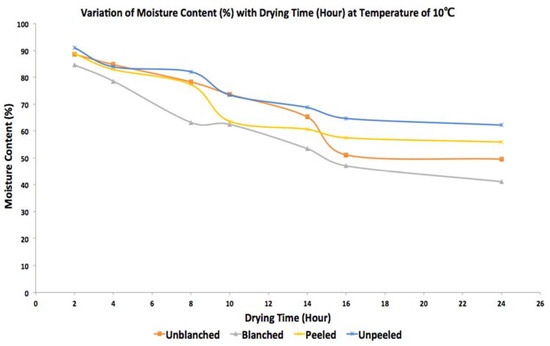
Figure 7.
Graphs of variation of moisture content (%) with drying time (hour) for ginger rhizomes at a temperature of 10 °C.
Figure 8 reveals that ginger is susceptible to drying at higher temperatures, as ginger dried at 50–60 °C exhibits surface darkening or colour changes. Therefore, any temperature higher than 60 °C should not be considered for future drying processes. In addition, industrial practices suggest a range of 60–70 °C as the maximum limit for drying ginger rhizomes, and research conducted by Hogue et al. [28] supports this, demonstrating a relatively high drying rate at 70 °C using a solar hybrid dryer.
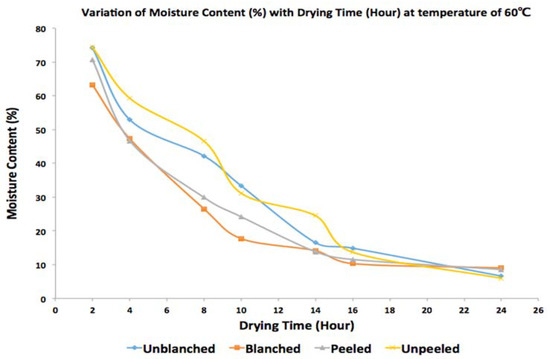
Figure 8.
Graphs of variation of moisture content (%) with drying time (hour) for ginger rhizomes at a temperature of 60 °C.
The impact of various drying conditions and factors is evaluated at different temperatures and durations. Figure 7 illustrates the correlation between moisture content and drying time, indicating that moisture content escalates with extended drying time and increased temperature. This observed relationship aligns with studies conducted by Ndukwu [29] and Jayas and Sokhansanj [30], which affirm the significant effect of temperature on the dehydration of ginger rhizomes, particularly at lower temperatures ranging from 10 °C to 20 °C. Its influence was relatively insignificant despite the constant humidity maintained during drying.
In terms of colour, a higher drying temperature not exceeding 60 °C and a lower final moisture content resulted in minimal or no discolouration of the product, as reported by Bonis & Ruocco et al. [31] and Attanasio et al. [32]. Thermal treatments led to alterations in the product, giving rise to different physical structures due to shrinkage, which affected the overall shapes and sizes after drying. This change was particularly noticeable in blanched, unblanched, peeled, and unpeeled ginger at temperatures between 40 °C and 60 °C, and drying times of 16 to 24 h, with blanched ginger showing the most noticeable change.
Unblanched sliced ginger was dried from an initial moisture content of 88.84% to 49.55% (wb) at 10 °C, 86.55% to 47.81% (wb) at 20 °C, 87.34% to 39.55% (wb) at 30 °C, 79.32% to 30.12% (wb) at 40 °C, 71.65% to 17.85% (wb) at 50 °C, and 74.16% to 6.63% (wb) at 60°C.
Blanched ginger’s moisture content ranged from 84.58% to 41.13% (wb) at 10 °C, 86.29% to 34.26% (wb) at 20 °C, 86.65% to 17.48% (wb) at 30 °C, 70.11% to 17.00% (wb) at 40 °C, 66.64% to 10.25% (wb) at 50 °C, and 63.11% to 9.04% (wb) at 60 °C.
Peeled ginger showed similar variations, with moisture content shifting from 88.74% to 55.91% (wb) at 10 °C, 87.85% to 37.49% (wb) at 20 °C, 87.95% to 27.76% (wb) at 30 °C, 75.93% to 23.92% (wb) at 40 °C, 65.50% to 13.21% (wb) at 50 °C, and 70.75% to 5.98% (wb) at 60 °C.
Unpeeled sliced ginger displayed a trend of increasing moisture content as temperature and drying time rose. The moisture content for unpeeled ginger was measured as 91.08% to 62.22% (wb) at 10 °C, 86.17% to 48.36% (wb) at 20 °C, 87.71% to 31.15% (wb) at 30 °C, 81.46% to 26.30% (wb) at 40 °C, 67.85% to 15.49% (wb) at 50 °C, and 74.36% to 5.98% (wb) at 60 °C.
The results above describe how the moisture content of ginger rhizomes—in unblanched, blanched, peeled, and unpeeled forms—changes when drying at different temperatures. The moisture content is expressed on a wet basis (wb), which refers to the amount of moisture present in a sample relative to the total weight of the sample (including the moisture). This means, for instance, that an initial moisture content of 88.84% (wb) indicates that 88.84% of the total weight of the sample is due to moisture.
As the temperature of the drying process increases, from 10 °C to 60 °C, the moisture content in each type of ginger rhizome decreases. For example, the moisture content of unblanched ginger decreases from 88.84% to 49.55% (wb) at 10 °C and from 74.16% to 6.63% (wb) at 60 °C. This pattern is observed across all the ginger forms tested, whether unblanched, blanched, peeled, or unpeeled. The specific values vary, but the trend remains the same: as temperature increases, moisture content decreases.
It is important to note that the drying process and the subsequent decrease in moisture content can affect the ginger’s texture, flavour, and thermal conductivity, which is why this process is often controlled in food processing applications.
Using environmental chambers, we noted fluctuations in the moisture content following a preliminary drying period spanning 2 to 24 h. Figure 9 and Figure 10 suggest that as the drying temperature rises, the speed at which ginger rhizomes dry also increases.
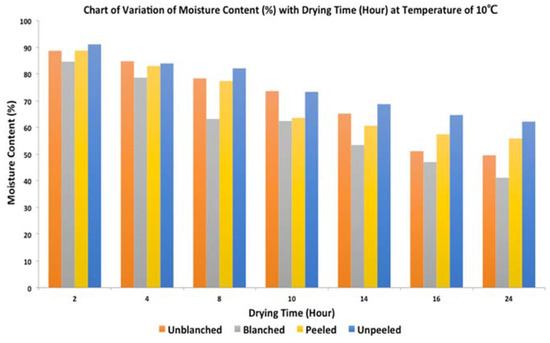
Figure 9.
Charts of variation of moisture content (%) with drying time (hour) for ginger rhizomes at a temperature of 10 °C.
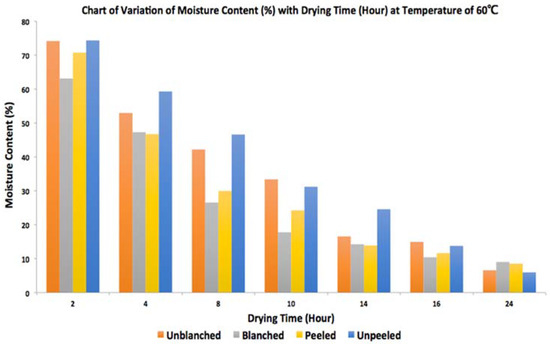
Figure 10.
Charts of variation of moisture content (%) with drying time (hour) for ginger rhizomes at a temperature of 60 °C.
4.3. Effect of Moisture Content on Thermal Properties of Dried Ginger Rhizomes
The moisture content substantially affects the thermal attributes of dried ginger rhizomes. As the rhizomes’ moisture content shifts throughout the drying process, their thermal properties, such as thermal conductivity, specific heat, and thermal diffusivity, also change. Grasping the impact of moisture content on these properties is vital for refining drying methods and predicting drying patterns.
- Thermal Conductivity: The thermal conductivity of ginger rhizomes strongly correlates with their moisture content. Higher moisture content typically leads to higher thermal conductivity values, as water is a more effective heat conductor than the solid elements of ginger. As the moisture content dwindles during the drying process, the thermal conductivity of the dried ginger rhizomes also lessens. This change in thermal conductivity can impact heat transfer and overall drying rates, influencing drying duration and energy utilisation.
- Specific Heat: Specific heat denotes the amount of heat necessary to elevate the temperature of a unit mass of a substance by one degree Celsius. The moisture content influences the specific heat of ginger rhizomes, given that water has a higher specific heat than solid constituents. As the moisture content diminishes, the specific heat of the dried ginger rhizomes also declines, translating into less heat needed to increase the material’s temperature during drying.
- Thermal Diffusivity: Thermal diffusivity assesses the speed at which heat can be disseminated through a material. It is influenced by the material’s thermal conductivity, specific heat, and density. As the moisture content of ginger rhizomes lessens, the thermal conductivity and specific heat decline while the density augments. These alterations can decrease thermal diffusivity, signifying that heat transfer through the dried ginger rhizomes becomes less effective as the drying process advances.
In summary, the moisture content of ginger rhizomes has a notable impact on their thermal properties, which encompass thermal conductivity, specific heat, and thermal diffusivity. Understanding the correlation between moisture content and thermal properties is vital for enhancing drying methods, minimising energy use, and preserving the quality of the final dried product.
The thermal attributes of ginger rhizomes are crucial in developing drying, processing, and storage apparatus. Accordingly, the thermal conductivity of ginger rhizomes was measured based on moisture content using linear conduction experimental equipment. Statistics indicate that Nigeria produced 136,730 metric tonnes of ginger between 2000 and 2012, and 45% succumbed to disease attacks [11]. The moisture content and thermal conductivity ranged from 88.84% to 49.55% (wb) at 10 °C for 2–24 h to 74.36% to 5.98% (wb) at 60 °C for the same duration. These increases in moisture content are also noticeable at 30–60 °C, exhibiting similar patterns as depicted in Figure 7. The thermal conductivity of this product ranged from 0.4064 at 10 °C and 2 h to 0.0553 at 60 °C and 24 h.
This relationship, as demonstrated in Figure 7, aligns with the findings of other researchers such as Bart-Plange et al. [33] for cowpea and maise; Perusulla, Viviana, and Mends [34] for banana Isa; Oladele and Akinlade [35] for egusi melon; and Singh and Goswani [36] for cumin seeds. Kurozawa, Park, and Azonbel [37] also noted this correlation between thermal conductivity and moisture content, finding that the thermal conductivity of cashew apples rose from 0.57 to 0.61 (6.6%) within 25–45 °C.
The thermal conductivity of unblanched, blanched, peeled, and unpeeled samples reveals that thermal conductivity enhances as moisture content escalates. This rise in thermal conductivity with moisture content can be attributed to the increase in water molecules within a ginger rhizome sample as the moisture content grows, filling the pores within the ginger sample and amplifying its ability to conduct more heat. This suggests the sample’s thermal energy intake was significantly higher at lower temperatures. However, the thermal energy dwindled at a higher temperature level due to its lower moisture content. Also, as water has a higher thermal conductivity than dried ginger rhizomes, it contributes to fresh ginger’s high thermal conductivity. The colour measurements of ginger rhizomes are beyond the purview of this research.
The results illustrated in Figure 11, Figure 12, Figure 13 and Figure 14 show that thermal conductivity increments as the moisture content rises. Higher inlet drying temperatures and times generally result in a reduction in moisture content. It is often observed that the greater the temperature disparity among particles, the more efficient the evaporation rate [12]. Similar outcomes have been reported by Chegini and Ghobadian [37] for sweet potato puree; Goula, Adamopoulos, and Kazakis [38] for dried tomato paste; Abadio et al. [39] for pineapple juice; and Phoungchandang and Sertwasana [40] for ginger powders. This result aligns with the work by Alibas [2], Kaya et al. [3], Ikechukwu et al. [41,42], Wang et al. [43], and Osae et al. [44].
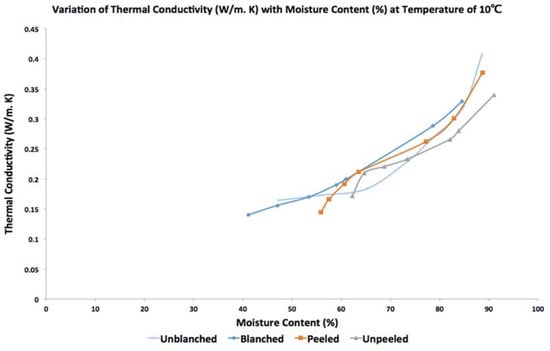
Figure 11.
Fluctuation of thermal conductivity () in ginger rhizomes with moisture content (%) at a temperature of 10 °C.
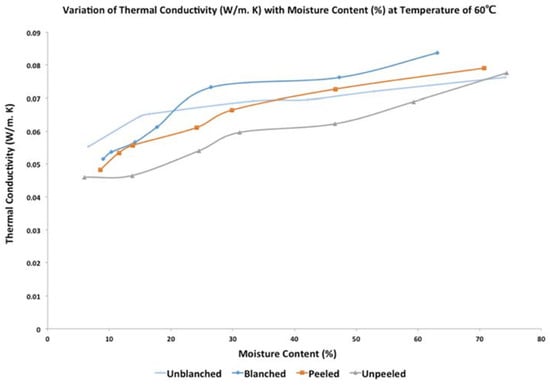
Figure 12.
Fluctuation in thermal conductivity () of ginger rhizomes with moisture content (%) at a temperature of 60 °C.
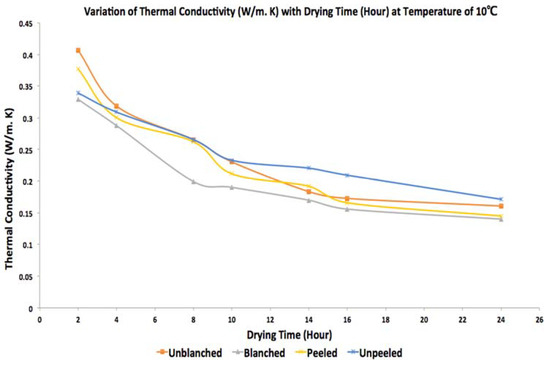
Figure 13.
Changes in thermal conductivity () of ginger rhizomes over drying time (hour) at a temperature of 10 °C.
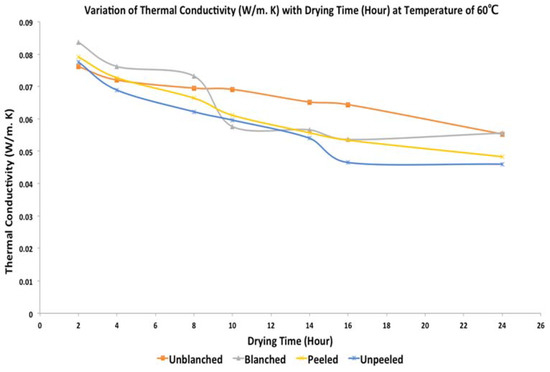
Figure 14.
Changes in the thermal conductivity () of ginger rhizomes over drying time (hour) at a temperature of 60 °C.
The data gathered confirms that as the moisture content increases, the drying of ginger rhizomes quickly leads to the hardening of the surface. This phenomenon diminishes the rate of thermal conductivity. This is because the hardened surface is a poor conductor of heat.
For unblanched ginger, the thermal conductivity at 10 °C declined from 0.4064 to 0.1607 , at 20 °C from 0.4064 to 0.1491 , at 30 °C from 0.1074 to 0.0677 , at 40 °C from 0.0756 to 0.0557 , at 50 °C from 0.0715 to 0.0541 , and at 60 °C from 0.0762 to 0.0553 . These measurements were recorded over drying periods of 2, 4, 8, 10, 14, 16, and 24 h.
Similar trends were detected for blanched ginger, with thermal conductivity at 10 °C dropping from 0.3290 to 0.1400 , at 20 °C from 0.2919 to 0.1312 , at 30 °C from 0.1006 to 0.0689 , at 40 °C from 0.0707 to 0.0562 , at 50 °C from 0.0730 to 0.0556 , and at 60 °C from 0.0836 to 0.0516 .
Likewise, peeled ginger saw declines in thermal conductivity at 10 °C from 0.3768 to 0.1449 , at 20 °C from 0.3768 to 0.1391 , at 30 °C from 0.1459 to 0.0652 , at 40 °C from 0.0717 to 0.0516 , at 50 °C from 0.0759 to 0.0519 , and at 60 °C from 0.0791 to 0.0483 .
For unpeeled ginger, the thermal conductivity at 10 °C lessened from 0.3397 to 0.1713 , at 20 °C from 0.3454 to 0.1713 , at 30 °C from 0.1126 to 0.0611 , at 40 °C from 0.0717 to 0.0543 , at 50 °C from 0.0776 to 0.0460 , and at 60 °C from 0.0776 to 0.0460 . These measurements were taken over 2 to 24 h of drying.
The results present an experiment measuring ginger rhizomes’ thermal conductivity in different states (unblanched, blanched, peeled, and unpeeled) at varying temperatures. Thermal conductivity measures a material’s ability to conduct heat, expressed in watts per metre-Kelvin ().
The research study concludes that the drying process significantly impacts the thermal conductivity of ginger rhizomes, with substantial decreases observed across all conditions tested. Notably, unblanched, blanched, peeled, and unpeeled ginger samples all experienced reductions in thermal conductivity of 86.39%, 84.32%, 87.18%, and 86.46%, respectively. These percentages reflect the changes from the initial measurement at 10 °C to the final state at 60 °C. The reduction in thermal conductivity aligns with the decrease in moisture content throughout the drying process. As water conducts heat more effectively than the solid components of ginger, this moisture loss consequently leads to diminished thermal conductivity in the rhizomes.
The various pre-processing treatments can explain the disparity in thermal conductivity reductions among the different ginger samples. The blanching process partially softens the tissue of the rhizomes, potentially leading to more efficient heat transfer and hence a slightly smaller reduction in thermal conductivity. On the other hand, peeling ginger exposes more of its surface area, allowing for more rapid moisture loss. This increased drying rate results in a lower final moisture content and a higher reduction in thermal conductivity. Thus, the study underscores the significant influence of both the drying process and pre-processing treatments on the thermal conductivity of ginger rhizomes.
Our research showed that the thermal conductivity of all forms of ginger rhizomes decreases consistently with increased drying time across all tested temperatures (10 °C to 60 °C). This can be attributed to “case hardening”, where rapid surface drying forms a crust, reducing overall heat conduction. However, the exact rates of thermal conductivity reduction varied depending on factors such as initial moisture content, the heat treatment process, and the ginger’s physical characteristics.
Overall, the results demonstrate the drying process’s significant impact on ginger rhizomes’ thermal conductivity, with different pre-processing treatments resulting in varied reductions in thermal conductivity. Understanding these changes is essential for optimising drying processes, minimising energy consumption, and maintaining the quality of the final dried product. The results obtained are in agreement with work reported by Jayashree, Visvanathan, and John [45] for peeled and unpeeled ginger and Jiřičková, Pavlík, and Černý [46] for biological agricultural materials.
4.4. A Comparative Analysis of Drying Characteristics between Nigerian Ginger Rhizomes and Other Varieties
Ginger (Zingiber officinale), a widely consumed spice, encompasses various cultivars cultivated worldwide, including Nigerian ginger rhizomes. Distinct growing conditions, climates, and genetic factors contribute to differences in the drying characteristics observed among ginger rhizomes from different cultivars. The drying characteristics of ginger are subject to variation based on the cultivar and the conditions in which it is grown. Several factors, such as initial moisture content, skin thickness, and inherent properties, come into play when examining these characteristics.
- Initial moisture content: The moisture content of freshly harvested ginger varies depending on the specific cultivar, growing conditions, and maturity stage at harvest time. The initial moisture content significantly impacts the drying process, including the required drying time and the appropriate drying method. Higher moisture content generally necessitates longer drying periods or more intense drying techniques. As a result, Nigerian ginger may exhibit a different moisture content than other cultivars, consequently influencing its drying characteristics.
- Skin thickness: The thickness of the ginger’s skin also influences the drying process. A thicker skin can impede moisture’s evaporation during drying, prolonging the drying time. Additionally, skin thickness may affect crucial quality aspects of the dried product, such as its colour, texture, and flavour. Nigerian ginger might have a distinctive skin thickness compared to other cultivars, impacting its drying characteristics accordingly.
- Inherent properties: Each ginger cultivar possesses inherent properties, including size, shape, density, oil content, and chemical composition. These properties can significantly impact the rate and efficiency of the drying process. For instance, ginger rhizomes with a higher oil content tend to dry more slowly due to the hygroscopic nature of oils. Similarly, larger or denser rhizomes might require more time to dry than smaller or less dense ones.
In summary, the drying characteristics of ginger rhizomes vary among different cultivars due to factors such as initial moisture content, skin thickness, and inherent properties. Understanding these variations is essential for optimising the drying process and achieving the desired quality attributes in the dried ginger product.
This paper compares the drying characteristics of Nigerian ginger rhizomes with those of other cultivars to provide insights into their performance in terms of drying time, energy consumption, and product quality.
- Drying Time: Nigerian ginger rhizomes, like other cultivars, exhibit a typical drying curve with a rapid initial drying rate followed by a slower, more gradual decrease in moisture content. However, Nigerian ginger rhizomes may have a shorter drying time than other cultivars due to their thinner skin and lower initial moisture content. In contrast, cultivars with a higher initial moisture content or thicker skin may require a longer drying time to reach the desired final moisture level.
- Energy Consumption: The energy consumption during the drying process depends on factors such as initial moisture content, drying temperature, and air velocity. Nigerian ginger rhizomes consume less energy during drying than other cultivars with a higher initial moisture content or those requiring higher drying temperatures to achieve similar drying rates. Efficient drying strategies can be employed to minimise energy consumption for all cultivars.
- Product Quality: The quality of dried ginger rhizomes is influenced by drying conditions, processing techniques, and the cultivar. Nigerian ginger rhizomes are known for their pungent aroma and high oleoresin content, which contribute to their desirable flavour and medicinal properties. While the drying process may lead to some loss of volatile compounds, the quality of Nigerian ginger rhizomes can be maintained by optimising drying conditions, such as temperature and air velocity, to minimise these losses. Other cultivars may exhibit different quality attributes, which should also be considered when optimising drying processes.
The drying characteristics of Nigerian ginger rhizomes differ from those of other cultivars due to factors such as initial moisture content, skin thickness, and inherent properties. Understanding these differences is essential for optimising drying processes and ensuring high-quality ginger products. Future research could investigate the drying kinetics of various ginger cultivars and develop models that accurately predict drying behaviour, energy consumption, and product quality.
4.5. Analysis of Drying Curves
The obtained drying curves for all conditions indicate that the drying process can only be accelerated up to a certain limit. Beyond this limit, the drying process remains unaffected by external conditions, such as room temperatures, and is primarily governed by moisture diffusion within the product. To increase the drying rate during this period, it is necessary to raise the temperature to around 50–60°C. This temperature increase will enhance the diffusion rate and potentially lead to an elevation in the drying air temperature within the chamber. However, it is crucial to note that a significant increase in air temperature would further deteriorate the product’s quality. The thermal conductivity curve reveals a correlation between the final moisture content of the product and its thermal conductivity, as depicted in Figure 11 and Figure 12.
Thermal conductivity, which is the ability of a material to conduct heat, is a multifaceted characteristic influenced by various factors. In the specific case of drying ginger rhizomes addressed in this study, the thermal conductivity relies on the material’s matrix and the amount of water it contains, as evident from Figure 11, Figure 12, Figure 13 and Figure 14.
There are several reasons for the correlation between increased moisture content and higher thermal conductivity, primarily associated with the properties of water itself:
- High thermal conductivity of water: Water possesses a higher thermal conductivity compared to many common substances found in ginger rhizomes, such as organic compounds. Consequently, as the water content within the rhizome increases, it enhances the efficient transfer of heat, thereby elevating the effective thermal conductivity of the material.
- Continuity of the water phase: Water molecules are dispersed and isolated within the material at low moisture content. However, as the moisture content rises, these dispersed water molecules can form a continuous phase, creating pathways for more effective heat conduction.
- Evaporative cooling: The process of water evaporation requires latent heat energy. This phenomenon aids in distributing heat efficiently throughout the material, which can be interpreted as an increase in thermal conductivity.
- Water as a bridge: Water can act as a bridge between solid particles, enhancing contact between them and facilitating heat conduction.
- Volume expansion: Water tends to expand when heated, and in a porous material like ginger rhizomes, this expansion can lead to an overall expansion of the material itself. Consequently, the structure of the rhizome can change, potentially creating more pathways for heat conduction.
During the drying of ginger rhizomes, the initial stages may exhibit increased thermal conductivity as the easily accessible water is removed, aiding in heat conduction. As the drying process progresses, tightly bound water within the material matrix is eliminated, which can decrease the thermal conductivity. Hence, the relationship between moisture content and thermal conductivity can be intricate and dependent on the specific drying stage.
Figure 13 and Figure 14 depict a decreasing trend in the thermal conductivity of unblanched, blanched, peeled, and unpeeled ginger over time. The highest thermal conductivity is observed at the 2 h mark, significantly declining until the 24 h drying time. These trends are most notable at temperatures between 10 °C and 20 °C, with a marked decrease between 30 °C and 60 °C for the various ginger samples.
In this study, the drying curves of ginger rhizomes exhibit three notable phases:
- Preheating Phase: This initial phase involves heating the ginger rhizomes to the drying air temperature. The moisture removal rate during this phase remains relatively low as the heat predominantly elevates the ginger samples’ temperature.
- Constant Rate Drying Phase: This phase transpires when the moisture removal rate remains steady, influenced primarily by external factors such as temperature, humidity, and air speed. Here, moisture from the surface of the ginger rhizomes is readily evaporated while moisture within the samples moves to the surface, maintaining a constant drying rate. A linear trend on the drying curve typically marks this phase.
- Falling Rate Drying Phase: This phase commences when the moisture removal rate begins to decline due to internal factors like reduced moisture content and increased resistance to moisture migration within the ginger samples. The drying curve displays a gradual reduction in the drying rate during this phase, ultimately arriving at an equilibrium moisture content. This falling rate drying phase can be further categorised into two sub-phases:
- (a)
- First Falling Rate Period: This period is defined by a slight decrease in the drying rate as the moisture migration from within the ginger rhizomes to the surface becomes the constraining factor.
- (b)
- Second Falling Rate Period: During this period, the drying rate decelerates even more as the residual moisture is more tightly bonded to the solid constituents of the ginger, and the resistance to moisture migration becomes progressively stronger.
Interpreting these drying curves for ginger rhizomes yields crucial insights into these agricultural commodities’ drying characteristics and kinetics. By grasping the various stages of the drying process and the factors influencing the drying rate, researchers can refine drying conditions, reduce energy use, and ensure the quality of the final dried product.
4.6. Impact of Air Temperature during Drying on Ginger Rhizomes
The drying air temperature plays a crucial role in influencing the drying curves of agricultural products, including ginger rhizomes. A drying curve plots the moisture content of the product against the drying time, indicating how quickly the product dries under specific conditions, as presented in Figure 7 and Figure 8.
As the drying air temperature increases, the rate of evaporation generally rises, leading to a steeper drying curve. This indicates a faster decrease in moisture content over time. Therefore, higher temperatures often result in shorter drying times.
However, the relationship between drying air temperature and the drying curve is not strictly linear. As the temperature rises beyond a certain point, the moisture removal rate plateaus or decreases due to internal limitations in the product, such as the diffusion rate of water to the surface. Therefore, an optimal drying air temperature usually maximises the moisture removal rate without negatively affecting the product quality.
For the ginger rhizome studied in this work, the optimal drying air temperature was found to be 60 °C. At this temperature, the convective drying process effectively reduced the rhizomes’ moisture content while preserving their quality, as reflected by a balanced drying curve and the resulting thermal conductivity values.
Moreover, excessively high drying air temperatures might degrade the quality of the product, causing changes in colour, texture, and nutritional value, thereby affecting the overall acceptability of the product. Hence, balancing rapid drying and product quality maintenance is vital when determining the optimal drying air temperature.
Further, the drying curves at different air temperatures also provide valuable insights into the energy efficiency of the drying process. Analysing these curves allows fine-tuning the drying process to ensure minimal energy usage while achieving the desired final moisture content.
4.7. Impact of the Drying Process on Ginger Rhizomes
Building on the core findings, the study’s in-depth investigation into the drying process of ginger rhizomes reveals critical nuances about their condition and quality. The thermal properties of the rhizomes shift significantly during drying, with a primary change being a decrease in thermal conductivity as moisture content reduces, as presented in Figure 11 and Figure 12. This relationship is crucial to understanding drying kinetics and developing effective drying strategies.
The efficiency of the convective drying method stands out among other techniques like open sun drying or solar tunnel drying. With convective drying, rhizomes achieve optimal dryness in just 24 h, compared to nine days in the open sun and eight days in the solar tunnel. The study also identifies a significant role of temperature in the drying process. A drying temperature of 60 °C is ideal for preserving the quality of the ginger rhizomes while ensuring energy efficiency.
The study identified unique optimal moisture content when examining different ginger rhizomes—unblanched, blanched, peeled, and unpeeled. For example, unblanched ginger has an optimal moisture content of 6.63% and a thermal conductivity of 0.0553 . Blanching increases the ideal moisture content to 9.04%. Still, the thermal conductivity drops slightly to 0.0516 . Peeling the ginger further adjusts these parameters, with an optimal moisture content of 8.56% and a thermal conductivity of 0.0483 . Lastly, unpeeled ginger has the lowest moisture content and thermal conductivity, at 5.98% and 0.0460 , respectively.
A reduction in thermal conductivity as the drying process proceeds indicates that ginger rhizomes become less efficient at conducting heat as they dry. The more moisture the rhizome contains, the more thermal energy is necessary to dry it, impacting drying time and energy consumption.
Our findings hold significant implications for the food industry, with the potential to catalyse the development of more energy-efficient and enhanced drying processes for ginger rhizomes. Moreover, the insights gathered open the prospect of application to other agricultural products and drying techniques. However, the expansion of these possibilities necessitates further research. Our study establishes a firm groundwork for future explorations in this domain, aspiring to optimise these processes for various product types to engineer energy-efficient drying methods that uphold product quality and minimise wastage in the agricultural sector.
Looking ahead, we recommend several paths for further inquiry. Future research should incorporate a wider variety of ginger from disparate regions to garner a more holistic understanding of the drying behaviour of different ginger types. It is also essential to extend investigations to consider other parameters, such as the influence of drying on colour, texture, and nutritional value. Comparative studies involving convective drying and other techniques, including sun drying, solar drying, or freeze drying, could unveil the most efficient and effective method. Additionally, examining the quality and shelf life of dried ginger during long-term storage could provide valuable insights. Lastly, an optimisation study to identify the best drying conditions—such as temperature, humidity, and air velocity—could significantly contribute to maximising energy efficiency and product quality. These suggestions seek to redress the limitations of our current study and provide broader, more comprehensive insights into the drying process of ginger rhizomes.
5. Conclusions
Our comprehensive study delves into the convective drying process of ginger rhizomes, with a particular focus on the correlation between moisture content and thermal conductivity. Using specialised equipment to mimic diverse drying conditions through our unique methodology, we measured ginger samples’ thermal conductivity at varying moisture content levels.
Our analysis revealed a significant link between moisture content and thermal conductivity. More precisely, as the moisture content declined during drying, a corresponding decrease in thermal conductivity was noted. Quantitatively, for unblanched ginger that initially had a moisture content of around 81% and a thermal conductivity of approximately 0.0553 , the thermal conductivity dropped to 0.0460 as drying progressed, and the moisture content fell to roughly 6.63%. This trend was consistently observed across all types of ginger evaluated—blanched, peeled, and unpeeled—underlining a robust relationship between moisture content and thermal conductivity in the drying process.
The implications of these findings are vital for the food industry, especially for drying and processing ginger and similar commodities. Our study highlights that understanding the interplay between moisture content and thermal properties can enhance drying strategies, boost energy efficiency, and preserve product quality.
Moreover, our findings indicate that ginger is highly temperature-sensitive, and optimal drying is achieved at 60 °C to maintain product quality. Ginger dried to a mean moisture content of 10% was suitable for storage and conversion into a medicinal and health-promoting powder.
Our research underscores the importance of optimising drying conditions to balance energy efficiency and product quality. The careful selection of drying temperature is essential to mitigate potential issues such as case hardening, discolouration, and loss of aromatic compounds. This research lays the groundwork for future studies exploring various drying techniques that could better maintain quality and energy efficiency, potentially contributing to the development of innovative drying technologies.
Interestingly, our investigation revealed that drying was slow at lower temperatures but increased between 30–60°C, with drying times ranging from 14 to 24 h. Furthermore, our findings suggest that peeled and blanched ginger reduces resistance to water transportation due to the permeability of the outer skin, thereby improving the drying process’s efficiency.
Author Contributions
Conceptualization, J.A.D. and S.M.; methodology, J.A.D.; validation, J.A.D. and S.M.; formal analysis, J.A.D.; investigation, J.A.D.; resources, S.M.; data curation, J.A.D.; writing—original draft preparation, J.A.D.; writing—review and editing, J.A.D. and S.M.; visualization, J.A.D.; supervision, S.M.; project administration, J.A.D. All authors have read and agreed to the published version of the manuscript.
Funding
This research received no external funding.
Institutional Review Board Statement
Not applicable.
Informed Consent Statement
Not applicable.
Data Availability Statement
Not applicable.
Acknowledgments
The study published in this report is funded by the School of Mechanical Engineering and the Built Environment, College of Engineering and Technology, University of Derby, UK and School of Engineering, Mechanical and Manufacturing Engineering, Medway, Kent.
Conflicts of Interest
The authors declare no conflict of interest.
References
- Prasad, K.N.; Yang, B.; Yang, S.; Chen, Y.; Zhao, M.; Ashraf, M.; Jiang, Y. Identification of phenolic compounds and appraisal of antioxidant and antityrosinase activities from litchi (Litchi sinensis Sonn.) seeds. Food Chem. 2011, 116, 1610–1618. [Google Scholar] [CrossRef]
- Alibas, I. Microwave, air and combined microwave-convective drying parameters of pumpkin slices. LWT Food Sci. Technol. 2007, 40, 1445–1451. [Google Scholar] [CrossRef]
- Kaya, A.; Aydın, O.; Dincer, S. Experimental and theoretical analysis of the drying of carrot slices in a convective dryer. Chem. Eng. Commun. 2008, 195, 1197–1211. [Google Scholar]
- Li, H.; Niu, X.; Chai, J.; Guo, C.; Sun, Y.; Li, J.; Li, C. Optimization of hot air drying process for tiger nut and analysis of fatty acid composition of tiger nut oil. Int. J. Agric. Biol. Eng. 2021, 14, 228–236. [Google Scholar] [CrossRef]
- Oyedele, A.O.; Akinoso, R.; Aboaba, S.A. Comparison of hot air and solar drying of ginger (Zingiber officinale) rhizomes. J. Food. Process. Preserv. 2017, 41, e12923. [Google Scholar]
- Dincer, I.; Dost, S. Experimental investigation of the drying kinetics of ginger slices. J. Food Eng. 2007, 81, 454–460. [Google Scholar]
- Nguyen, M.H.; Nguyen, D.L.; Nguyen, T.T.H. Drying characteristics and effective moisture diffusivity of ginger (Zingiber officinale Roscoe) using convective drying method. J. Sci. Technol. Dev. 2018, 21, 11–18. [Google Scholar]
- Feng, H.; Tang, J.; Mattinson, D.S.; Fellman, J.K. Quality retention in strawberry and carrot purees dried with Refractance WindowTM system. J. Food Eng. 2015, 146, 89–94. [Google Scholar] [CrossRef]
- Doymaz, I. Drying of ginger slices in a convective hot-air dryer. Int. J. Food Sci. Technol. 2011, 46, 602–607. [Google Scholar]
- Opara, U.L.; Al-Ani, M.R.; Al-Shuaibi, Y.S. Physico-chemical properties, vitamin C content, and antimicrobi-al properties of pomegranate fruit (Punica granatum L.). Food Bioproc. Tech. 2014, 7, 3156–3167. [Google Scholar]
- Myers, R.H.; Montgomery, D.C.; Anderson-Cook, C.M. Response Surface Methodology: Process and Product Optimisation Using Designed Experiments, 4th ed.; John Wiley & Sons, Inc.: Hoboken, NJ, USA, 2016. [Google Scholar]
- Erenturk, S.; Erenturk, K.; Tabil, L.G. Infrared drying of carrot slices. Journal of Food Processing and Preservation. J. Food Process. Preserv. 2010, 34, 457–471. [Google Scholar] [CrossRef]
- Namsanguan, Y.; Tansakul, A.; Lamsal, B.P.; Chiewchan, N.; Devahastin, S. Drying kinetics and quality of potato chips undergoing different drying processes. J. Food Eng. 2004, 64, 335–340. [Google Scholar] [CrossRef]
- Ikechukwu, G.A. Prediction of Thin Layer Drying Characteristics of Ginger Rhizomes Slices in Convective Environment. Ph.D. Thesis, Nnamdi Azikiwe University, Awka, Nigeria, 2021. [Google Scholar]
- Bialik, M.; Wiktor, A.; Rybak, K.; Witrowa-Rajchert, D.; Latocha, P.; Gondek, E. The Impact of Vacuum and Convective Drying Parameters on Kinetics, Total Phenolic Content, Carotenoid Content and Antioxidant Capacity of Kiwiberry (Actinidia arguta). Appl. Sci. 2020, 10, 6914. [Google Scholar] [CrossRef]
- Hamid, K.; Sajjad, U.; Yang, K.S.; Wu, S.-K.; Wang, C.-C. Assessment of an energy efficient closed loop heat pump dryer for high moisture contents materials: An experimental investigation and AI based modelling. Energy 2022, 238, 121819. [Google Scholar] [CrossRef]
- Çelik, Y.; Kenanoğlu, B.B. After-ripening effect combined with drying methods on seed quality of aubergine seed lots harvested at different maturity stages. Kuwait J. Sci. 2023. [Google Scholar] [CrossRef]
- Zhang, Z.-S.; Jia, H.-J.; Li, X.-D.; Liu, Y.-L.; Wei, A.-C.; Zhu, W.-X. Effect of drying methods on the quality of tiger nuts (Cyperus esculents L.) and its oil. LWT 2022, 167, 113827. [Google Scholar] [CrossRef]
- Akther, S.; Jothi, J.S.; Badsha, R.; Rahman, M.; Das, G.B.; Alim, A. Drying methods effect on bioactive compounds, phenolic profile, and antioxidant capacity of mango powder. J. King Saud Univ. Sci. 2023, 35, 102370. [Google Scholar] [CrossRef]
- Umunna, M.F.; Simonyan, K.J.; Paul, T.; Okosa, I. Drying characteristics of indigenous ginger rhizomes under. J. Agric. Eng. Technol. (JAET) 2022, 27, 54–68. [Google Scholar]
- Eze, J.; Agbo, K. Comparative studies of sun and solar drying of peeled and unpeeled ginger. Am. J. Sci. Ind. Res. 2011, 2, 136–143. [Google Scholar] [CrossRef]
- Ndukwu, M.C.; Ben Augustine, E.; Ugwu, E.; Ibeh, M.I.; Ekop, I.; Akpan, G.; Udo, A.E.; Ihediwa, V.E.; Akuwueke, L.; Mbanasor, J.; et al. Drying kinetics and thermo-economic analysis of drying hot water blanched ginger rhizomes in a hybrid composite solar dryer with heat exchanger. Heliyon 2023, 9, e13606. [Google Scholar] [CrossRef]
- Netzsch. Thermal Analysis; A Netzsch Group Ltd.: Selb, Germany, 2023; Available online: https://analyzing-testing.netzsch.com/en/training-know-how/glossary/thermal-conductivity (accessed on 20 June 2023).
- Tecquipment. A. TecQuipment Ltd. Retrieved 11 March 2015, from A. TecQuipment Ltd. 2015. Available online: https://www.tecquipment.com/linear-heat-conduction-experiment (accessed on 20 June 2023).
- Mahapatra, A.; Lan, Y.; Harris, D. Influence of Moisture Content and Temperature on Thermal Conductivity and Thermal Diffusivity of Rice Flours. Int. J. Food Prop. 2011, 14, 675–683. [Google Scholar] [CrossRef]
- Lakatos, Á.; Csáky, I.; Kalmár, F. Thermal conductivity measurements with different methods: A procedure for the estimation of the retardation time. Mater. Struct. 2015, 48, 1343–1353. [Google Scholar] [CrossRef]
- Mathobo, V.M.; Silungwe, H.; Ramashia, S.E.; Anyasi, T.A. Effects of heat-moisture treatment on the thermal, functional properties and composition of cereal, legume and tuber starches—A review. J. Food Sci. Technol. 2021, 58, 412–426. [Google Scholar] [CrossRef] [PubMed]
- Hogue, M.T.; Bala, B.K.; Hossain, M.A.; Borhan, M.S. Drying of ginger using solar hybrid dryer. Int. J. Agric. Res. Innov. Technol. 2013, 3, 29–34. [Google Scholar]
- Ndukwu, M.C. Development and evaluation of a solar dryer for ginger rhizomes. Afr. J. Agric. Res. 2009, 4, 1037–1042. [Google Scholar]
- Jayas, D.S.; Sokhansanj, S. Drying of Foodstuffs; Marcel Dekker Inc.: New York, NY, USA, 1999. [Google Scholar]
- De Bonis, M.V.; Ruocco, G. A generalized conjugate model for forced convection drying based on an evaporative kinetics. J. Food Eng. 2008, 89, 322–329. [Google Scholar] [CrossRef]
- Attanasio, G.; Cinquanta, L.; Albanese, D.; Di Matteo, M. Effects of drying temperatures on physico-chemical properties of dried and rehydrated chestnuts (Castanea sativa). Food Chem. 2004, 88, 583–590. [Google Scholar] [CrossRef]
- Bart-Plange, A.; Addo, A.; Amponsah, S.K.; Ampah, J. Thermal Conductivity of Two Varieties of Maize (Zea mays) and Cowpea (Vigna unguiculata) as a Function of Moisture Content and Temperature. Int. J. Food Eng. 2012, 8, 1–20. [Google Scholar]
- Perusulla, S.; Viviana, R.; Mends, R. Thermal conductivity of banana fruit during ripening. Food Eng. 2010, 100, 604–609. [Google Scholar] [CrossRef]
- Isa, M.C.; Oladele, A.K.; Akinlade, G.O. Thermal conductivity of egusi melon seed. Int. J. Sci. Eng. Res. 2014, 5, 1171–1176. [Google Scholar]
- Singh, R.K.; Goswami, T.K. Thermal conductivity of cumin seed as a function of moisture content and temperature. J. Food Sci. Technol. 2000, 37, 94–96. [Google Scholar]
- Chegini, G.R.; Ghobadian, B. Effect of Spray-Drying Conditions on Physical Properties of Orange Juice Powder. Dry. Technol. 2007, 25, 473–479. [Google Scholar] [CrossRef]
- Goula, A.M.; Adamopoulos, K.G.; Kazakis, N.A. Influence of spray drying conditions on tomato powder properties. Dry. Technol. 2004, 22, 1129–1151. [Google Scholar] [CrossRef]
- Abadio, F.D.B.; Domingues, A.M.; Borges, S.V.; Oliveira, V.M. Physical properties of powdered pineapple (Ananas comosus) juice-effect of malt dextrin concentration and atomisation speed. J. Food Eng. 2004, 64, 285–287. [Google Scholar] [CrossRef]
- Phoungchandang, S.; Sertwasana, A. Spray drying of ginger juice and physicochemical properties of ginger powders. Songklanakarin J. Sci. Technol. 2010, 32, 327–335. [Google Scholar]
- Ikechukwu, G.A.; Omenyi, S.N. Convective drying of ginger rhizomes. In Lecture Notes in Engineering and Computer Science; Springer: Singapore, 2017. [Google Scholar] [CrossRef]
- Ikechukwu, G.A.; Mallik, S.; Njoku, J.E.E.; Depriver, J. Experimental Analysis of Thin Layer Drying of Ginger Rhizome in Convective Environment. Adv. Sci. Technol. Eng. Syst. J. 2020, 5, 1132–1142. [Google Scholar] [CrossRef]
- Wang, Y.; Zhang, M.; Mujumdar, A.S. Convective Drying Kinetics and Physical Properties of Silver Carp (Hypophthalmichthys molitrix) Fillets. J. Aquat. Food Prod. Technol. 2011, 20, 361–378. [Google Scholar] [CrossRef]
- Osae, R.; Alolga, R.N.; Essilfie, G.; Osei-Adjei, G.; Baduweh, C.A.; Yarley, O.P.N.; Zhou, C. Variation in bioactive phytochemicals and sensory attributes of osmosonic convective dried ginger from four African countries. J. Sci. Food Agric. 2020, 100, 3164–3172. [Google Scholar] [CrossRef]
- Jayashree, E.; Visvanathan, R.; John, M. Effect of pre-treatments on drying characteristics of ginger (Zingiber officinale) by convective drying. J. Food Sci. Technol. 2012, 49, 760–766. [Google Scholar]
- Jiřičková, M.; Pavlík, Z.; Černý, R. Moisture-dependent thermal conductivity of agricultural materials. J. Food Eng. 2006, 73, 186–191. [Google Scholar] [CrossRef]
Disclaimer/Publisher’s Note: The statements, opinions and data contained in all publications are solely those of the individual author(s) and contributor(s) and not of MDPI and/or the editor(s). MDPI and/or the editor(s) disclaim responsibility for any injury to people or property resulting from any ideas, methods, instructions or products referred to in the content. |
© 2023 by the authors. Licensee MDPI, Basel, Switzerland. This article is an open access article distributed under the terms and conditions of the Creative Commons Attribution (CC BY) license (https://creativecommons.org/licenses/by/4.0/).